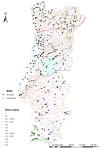Invasibility of Mediterranean-climate rivers by non-native fish: the importance of environmental drivers and human pressures
- PMID: 25372284
- PMCID: PMC4220925
- DOI: 10.1371/journal.pone.0109694
Invasibility of Mediterranean-climate rivers by non-native fish: the importance of environmental drivers and human pressures
Abstract
Invasive species are regarded as a biological pressure to natural aquatic communities. Understanding the factors promoting successful invasions is of great conceptual and practical importance. From a practical point of view, it should help to prevent future invasions and to mitigate the effects of recent invaders through early detection and prioritization of management measures. This study aims to identify the environmental determinants of fish invasions in Mediterranean-climate rivers and evaluate the relative importance of natural and human drivers. Fish communities were sampled in 182 undisturbed and 198 disturbed sites by human activities, belonging to 12 river types defined for continental Portugal within the implementation of the European Union's Water Framework Directive. Pumpkinseed sunfish, Lepomis gibbosus (L.), and mosquitofish, Gambusia holbrooki (Girard), were the most abundant non-native species (NNS) in the southern river types whereas the Iberian gudgeon, Gobio lozanoi Doadrio and Madeira, was the dominant NNS in the north/centre. Small northern mountain streams showed null or low frequency of occurrence and abundance of NNS, while southern lowland river types with medium and large drainage areas presented the highest values. The occurrence of NNS was significantly lower in undisturbed sites and the highest density of NNS was associated with high human pressure. Results from variance partitioning showed that natural environmental factors determine the distribution of the most abundant NNS while the increase in their abundance and success is explained mainly by human-induced disturbance factors. This study stresses the high vulnerability of the warm water lowland river types to non-native fish invasions, which is amplified by human-induced degradation.
Conflict of interest statement
Figures



Similar articles
-
Interspecific aggressive behaviour of invasive pumpkinseed Lepomis gibbosus in Iberian fresh waters.PLoS One. 2014 Feb 5;9(2):e88038. doi: 10.1371/journal.pone.0088038. eCollection 2014. PLoS One. 2014. PMID: 24505367 Free PMC article.
-
Life-history variability of non-native centrarchids in regulated river systems of the lower River Guadiana drainage (south-west Iberian Peninsula).J Fish Biol. 2010 Feb;76(3):522-37. doi: 10.1111/j.1095-8649.2009.02506.x. J Fish Biol. 2010. PMID: 20666894
-
Monogenean parasites of introduced pumpkinseed Lepomis gibbosus (Centrarchidae) in the Danube River Basin.J Helminthol. 2011 Dec;85(4):435-41. doi: 10.1017/S0022149X10000805. Epub 2010 Dec 23. J Helminthol. 2011. PMID: 21208472
-
Climate and land-use changes affecting river sediment and brown trout in alpine countries--a review.Environ Sci Pollut Res Int. 2009 Mar;16(2):232-42. doi: 10.1007/s11356-008-0075-3. Epub 2008 Dec 2. Environ Sci Pollut Res Int. 2009. PMID: 19048320 Review.
-
Non-native freshwater fauna in Portugal: A review.Sci Total Environ. 2019 Feb 10;650(Pt 2):1923-1934. doi: 10.1016/j.scitotenv.2018.09.251. Epub 2018 Sep 24. Sci Total Environ. 2019. PMID: 30286358 Review.
Cited by
-
MicroRNA-34a: the bad guy in age-related vascular diseases.Cell Mol Life Sci. 2021 Dec;78(23):7355-7378. doi: 10.1007/s00018-021-03979-4. Epub 2021 Oct 26. Cell Mol Life Sci. 2021. PMID: 34698884 Free PMC article. Review.
References
-
- Clavero M, Garcia-Berthou E (2006) Homogenization dynamics and introduction routes of invasive freshwater fish in the Iberian Peninsula. Ecol Appl 16: 2313–2324. - PubMed
-
- Marr SM, Olden JD, Leprieur F, Arismendi I, Ćaleta M, et al. (2013) A global assessment of freshwater fish introductions in Mediterranean-climate regions. Hydrobiologia 719: 317–329.
-
- Benejam L, Carol J, Benito J, Garcia-Berthou E (2007) On the spread of the European catfish (Silurus glanis) in the Iberian Peninsula: first record in the Llobregat river basin. Limnetica 26: 169–171.
-
- Caiola N, de Sostoa A (2002) First record of the Asiatic cyprinid Pseudorasbora parva in the Iberian Peninsula. J Fish Biol 61: 1058–1060.
Publication types
MeSH terms
LinkOut - more resources
Full Text Sources
Other Literature Sources

